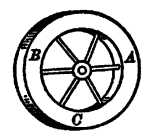Local Motion Versus Zeno
Table of Contents
Proposition 6: Matter is indefinitely extended. The matter of the heavens and the earth is one and the same.
Proof 1. We cannot imagine the boundaries of extension, that is (Prop. 2 Part 2), of matter, without conceiving other spaces immediately following or beyond them (Ax. 10), that is, without conceiving extension or matter (Def. 6) beyond them, and so on indefinitely.
Proof 2: The essence of matter consists in extension (Prop. 2 Part 2).
This is indefinite (first part of this proof)– it cannot be conceived by the human intellect as having any boundaries.
Therefore (Ax. I I ) it is not a manifold but everywhere one and the same.
Scholium: Extension exists such as we conceive it, created by God.
We have proven this in:
- the last Proposition of Part 1
- Part 1, Prop. 12
It follows that extension is now preserved by the same power that created it.
In that same last Proposition of Part I, we proved that, insofar as we are thinking things, we are united to some part of matter.
This matter helps us perceive that there are in actuality all those variations whereof, by merely contemplating matter, we know it to be capable.
Such are divisibility and local motion or movement of one part from one place to another, which we clearly and distinctly perceive provided that we understand that other parts of matter take the place of those that move.
This division and motion are conceived by us in infinite ways. Therefore, infinite variations of matter can also be conceived.
They are clearly and distinctly conceived by us as long as we conceive them as modes of extension, not as things distinct in reality from extension, as explained in Principia Part 1.
Local Motion
Philosophers have fabricated any number of other motions.
However, extension [metaphysical space] is only capable of local motion.
And so, we must not admit any other motion but local motion.
But Zeno denied local motion.
Diogenes the Cynic refuted him by walking around the school where Zeno was teaching these doctrines and disturbing his listeners with his perambulations.
He was stopped by one of Zeno’s students whom he rebuked, saying: Why have you refuted your master’s arguments?
People could be deceived by Zeno’s arguments into thinking that the senses reveal to us motion that is totally opposed to the intellect.
This results in the mind being deceived about those things that it perceives clearly and distinctly with the aid of the intellect.
To prevent this, I explain Zeno’s principal arguments, showing that they are based on false prejudices because he had no true conception of matter.
He says that if local motion were granted, the motion of a body moving with a circular motion at the highest speed would be no different from a state of rest.
But the latter is absurd. Therefore so is the former.
He proves the consequence as follows:
- A body whose every point remains constantly in the same place is at rest.
- But all the points of a body moving with a circular motion at the highest speed remain constantly in the same place.
He gives the example of a wheel ABC.

If the wheel were to move about its center at a certain speed, point A would complete a circle through B and C more quickly than if it were to move at a slower speed.
So suppose, for example, that it begins to move slowly, and that after an hour it is in the same place from which it began.
Now if it be supposed that it moves at twice that speed, it will be in the same place from which it began after half an hour.
If at 4 times the speed, after quarter of an hour.
If we conceive the speed to be infinitely increased and the time to be reduced to moments, then the point A at its highest speed will be at all moments, or constantly, in the place from which it began to move, and so it always remains in the same place.
What we understand about point A must also be understood about every point of the wheel. Therefore, at the highest speed, all points remain constantly in the same place.
I reply that this is an argument directed against motion’s highest speed rather than against motion itself.